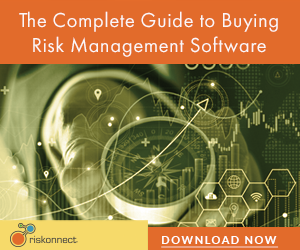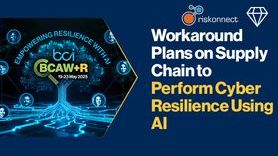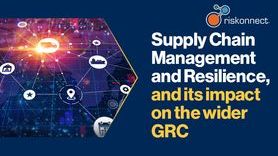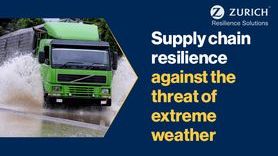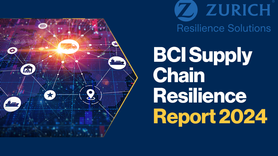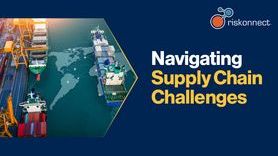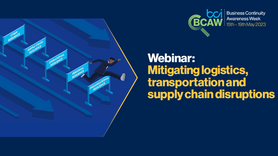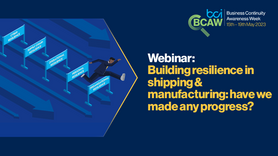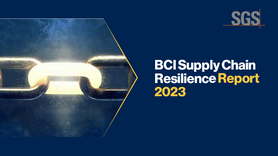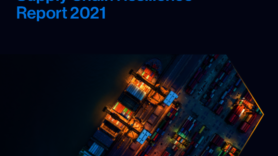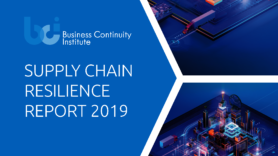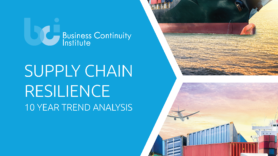What does supply chain resilience mean in 2024?
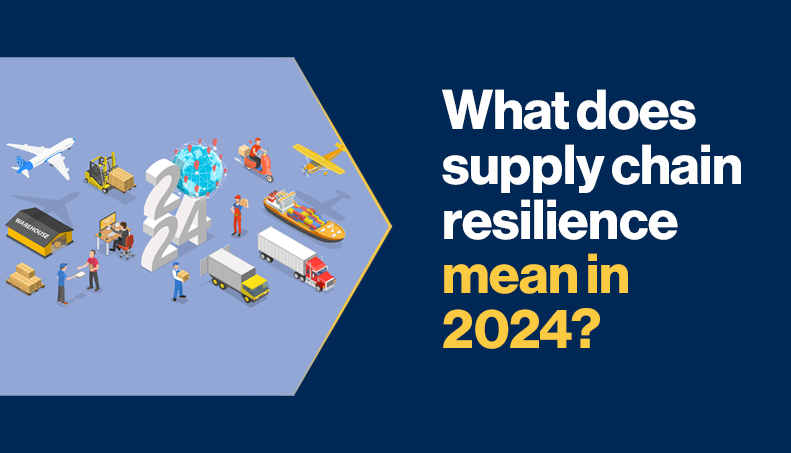
The persistent congestion in transportation and logistics infrastructure, coupled with container shortages, geopolitical tensions, economic uncertainties, conflicts, rising cyber threats, and frequent extreme weather events, has heightened awareness amongst organizations that supply chain disruptions are becoming increasingly commonplace. Therefore, it is imperative for organizations to adapt by proactively managing and preparing for supply chain risks and disruptions rather than merely reacting to problems as they occur.
2024 – how to prepare for supply chain disruptions
Organizations must now fortify themselves against disruptive political and environmental challenges that pose a threat to supply chains. Central to this is a thorough understanding of the vulnerabilities and potential failure points within these chains. This involves adapting disaster recovery, business continuity, and emergency plans while leveraging state-of-the-art technology and fostering collaboration with integrated logistics partners.
A recent study by Gartner, Balancing Sustainability and Resilience[1], highlights that a change in business approaches is taking place when it comes to demonstrating risk resilience. That is supply chains are shifting from a focus on low costs and optimisation to prioritising risk resilience and sustainability. This is a change that requires a delicate balance to maintain reasonable costs without compromising business efficiency or profits, as well as being able to prepare for a wide range of potential scenarios.
Supply chain trends and risks to watch in 2024
Organizations need to pay close attention to both existing and emerging supply chain trends and risks.
TRENDS
Supply chain digitalisation/innovation - Supply chains are becoming increasingly complex and organizations should aim to become more resilient in the face of increased bottlenecks.
According to the Supply Chain Trends & Insights: Innovation[2] report, published by Catena Solutions, organizations significantly increased their investments in supply chain innovation in 2023, almost doubling their average spending from the previous year. In addition, the research found that 67% of CEOs plan to increase investment in disruption detection and innovation processes.
It is worth noting that the main events that triggered this wave of investment include labour shortages, extreme weather events, growing consumer demand (in quantity and quality), and rising shipping costs (which, according to Catena Solutions, increased by 86% during the pandemic and continue to impact the supply chain[3]).
As a result, 2024 will see a continued increase in the use of digital platforms to:
- increase supply chain visibility;
- optimise logistics;
- and enable greater adaptability and responsiveness.
Supply chain technology - Warehouse automation and robotics are also becoming part of supply chain management. As the challenge of recruitment and retention of skilled workers across the supply chain becomes greater and employees demand salaries to match rising living costs, warehouse technologies are proving a cost-effective way of managing these challenges.
According to a July 2023 Gartner study, Hype Cycle for Mobile Robots and Drones[4], labour shortages and challenges in retaining talent, along with various technological advances, will continue to drive the adoption of intelligent robots. In this context, these mobile ‘robots’ could serve multiple purposes, such as intralogistics, manufacturing, site inspections, security, autonomous data collection, cleaning, and even transportation. Mobile robots may be able to perform these tasks in the air, on the ground, or in water (both indoors and, in some cases, outdoors).
Indeed, more than three-quarters of companies will have adopted some form of cyber-physical automation in warehouse operations by 2027. Therefore, it is likely that there will be thousands more mobile robots working in supply chains within the next three years.
For example, DHL Supply Chain has announced its intention to inaugurate four additional automated warehouses using automated storage and retrieval systems which aim to increase productivity while enabling rapid scalability and adaptability to fluctuations in demand[5].
In fact, in 2024, warehouse automation will continue to evolve, with an increased focus on robotics to improve efficiency, increase order fulfilment speed, and reduce labour costs.
The rise of near-shoring – Near-shoring is the practice of moving production closer to the customer and/or company headquarters. This trend is driven by a number of factors, including geopolitical tensions, the requirement for greater supply chain transparency, the growing importance of speed to market, and the need for greater supply chain resilience. Some organizations, such as clothing manufacturers, are bringing textile production back into their own countries. One such example is the UK-based fashion business, David Nieper. Having been the victim of significant supply chain disruption causing both lost sales and exorbitant shipping costs, the business has invested in the local economy and brought production back to the UK.
Other consumer products and retail companies are also progressively broadening and localising their supply chain networks. As per the report released by the global think tank Capgemini Research Institute, Illuminating the path: Building resilient and efficient supply chains in the consumer products and retail industry[6], almost 8 out of 10 companies (79%) are diversifying their supplier base, with 71% actively investing in regionalisation and localisation. In addition, 83% of organizations are actively investing in friend-shoring, a growing practice in which supply chain networks focus on countries considered political and economic allies to further reduce risk exposure.
There is now widespread belief that a growing number of companies in 2024 will embrace near-shoring strategies to construct supply chains capable of fostering profitable growth and resilience against potential disruptions in the future.
Risks
Global political unrest or geopolitical risk – Global political instability continues to contribute to supply chain disruption. High-profile conflicts such as the trade war between the United States and China, the conflict between Russia and Ukraine, and the conflict between Israel and Palestine are prime examples of how global events can impact supply chains, often with disruptive effects.
Indeed, attacks on ships in the Red Sea in recent months has led to severe impacts on global trade. The Kiel Institute for the World Economy reported that the number of containers shipped through the Red Sea fell by more than half from around 5000 containers per day in November to 2000 in December[7]. To avoid passing through the Red Sea, freight organizations are taking the longer route around the Cape of Good Hope — with the obvious implications this brings to the supply chain in terms of increased costs (fuel, man hours, etc) and delays.
Organizations are now having to determine the impacts to production this might cause. Tesla has recently announced a two-week-long production hiatus at its production facility in Berlin due to delays in the delivery of parts, which has been impacted by the situation in the Red Sea[8]. The Red Sea issues have also been compounded by drought affecting the Panama Canal: authorities have been forced to cancel ship crossings by 36% as a result, with the potential cost implications running to almost US$1bn[9].
Therefore, it is clear that we are facing geopolitical dynamics that create unpredictable operating environments which lead to increased costs and greater management complexity. Supply chains are also becoming less efficient and, for those organizations who lack the financial means to change suppliers or invest in systems to help improve efficiencies, the future is far from rosy.
Elsewhere, it is important to remember that geopolitical risks are not limited to the world stage. Domestically, internal political dynamics – including conflicts between political parties, demonstrations, workers' strikes, and other events – significantly disrupt supply chains.
However, organizations can put strategies in place to maintain business continuity, remembering that one strategy for resilience is not to over-rely on a single vendor for at least a substantial portion of their products. That is, by diversifying their supplier base, organizations can make more flexible decisions and allocate resources optimally within their supply chains, while remaining proactive in the face of risks.
Technologies such as artificial intelligence and predictive analytics may also be able to improve supply chain agility, allowing organizations to quickly identify the most resilient suppliers within their supply chain and mitigate risks. The BCI Technology in Resilience Report[10] highlights the value of real-time monitoring tools, which can provide an early alert about problems developing in the supply chain and give organizations an opportunity to make changes before severe issues develop.
Economic challenges and managing inflation - Inflation has significantly affected supply chains in various industries recently. During the pandemic, there was a surge in demand for consumer products which tested the capacity of supply chains globally. However, meeting this demand proved increasingly difficult as lockdowns around the world disrupted logistics operations, leading to increased production and transportation costs.
Amplified by the pandemic-induced labour shortages and the need for stringent health measures, managing supply chains has become more intricate. As a result, some organizations are pivoting towards automation to offset the expanding labour deficits and align with consumer demand. This trend is particularly prominent in sectors significantly affected by supply chain pressures and uncertainties, including manufacturing, distribution, order fulfilment, and e-commerce.
Furthermore, the escalation of costs relating to raw materials, transportation, and labour poses a significant risk factor for the supply chain as this heightened cost scenario is anticipated to persist in the near- to mid-term and continuously impact production costs.
Indeed, as noted above, the current geopolitical unrest is also impacting supply chain costs with some shipping lanes increasing rates by up to 40% due to the recent scenario in the Red Sea[11]. Placing this in the context of this already heightened cost environment, it is clear to see why so many organizations are struggling to meet the inflated costs required.
These findings are backed up by a report from the consulting firm McKinsey, Navigating the new normal: Operations insights for 2024[12]. The article highlighted an anticipated surge in rates across the entire supply chain, projected at 2.9% in 2024. The firm attributes this to the persistent impact of ongoing economic and geopolitical market shifts, heightened cost pressures, and the enduring disruptions within supply chains.
The inflationary climate has also added to the cost dynamics within supply chain operations. In the past, operational and productivity initiatives were effective in offsetting the impact of inflation. However, with current inflation rates ranging between 7% and 10%, mitigating these effects has become notably more challenging. This situation adds significant pressure on supply chains and organizations, requiring them to respond swiftly to effectively navigate and manage these challenging circumstances.
Climate change and compliance with ESG standards – The increased frequency and severity of climate risks – such as extreme weather events – are expected to result in further disruptions in global supply chains and be another factor in the rising costs and prices.
The impact is likely to be felt differently across different sectors. For example, semiconductor and rare earth metals manufacturers are concentrated in geographical regions that face a higher probability of significant climate risks. Therefore, organizations must understand and embrace a resilient approach when collaborating with their suppliers to ensure the resilience of their supplier network, as well as ensuring their own business continuity and resilience plans are capable of ensuring operational can continue in the face of severe disruption.
Taiwan, for example, has seen extreme droughts affect the production of semiconductor chips as the manufacturing process requires vast amounts of water. As one of the key hubs in the semiconductor industry, this single climate event can destabilise the many industries which rely on this piece of technology.
In addition, an organization’s investors and customers expect adherence to environmental, social, and governance (ESG) principles and sustainability standards. This necessitates ensuring compliance not only within its own operations, but also throughout its supplier network. Compliance may also require significant upfront investments — another challenge for organizations working within constrained budgets. Additionally, although embracing sustainable practices ensures environmentally friendly sourcing, it might limit supplier diversification. This constraint could confine organizations to partnering only with suppliers that meet strict sustainability criteria.
To thrive in this era of climate uncertainties, it is vital for suppliers to embed sustainability practices in their operations. This is not merely for their own sustainability, but also to aid client organizations in achieving their sustainability goals. This shared dedication to sustainability is critical to effectively tackle the challenges posed by climate change.
Heightened evolution of the cyber threat landscape - The cyber threat landscape is undergoing rapid change for organizations and their third-party vendors. The BCI Supply Chain Resilience Report 2023[13] found cyber-attacks and data breaches to be the greatest concern in the sector over the next five years. Indeed, it has become more crucial than ever to meticulously evaluate when and how first-party data is shared with suppliers.
As organizations grapple with the intricate nature of these supplier networks, often involving numerous third parties, the complexity becomes an ideal target for hackers due to the reduced traceability and transparency. For instance, the cybersecurity measures implemented (or absence thereof) by a vendor can significantly expose an organization to various risks.
While AI and threat intelligence-based security solutions may bolster the capacity to anticipate and detect cyber threats, it is important to note that cybercriminals are also utilizing these technological advancements to enhance their attack strategies and techniques. Organizations must therefore forge collaborative partnerships with their partners to fortify cybersecurity measures. This involves verifying that suppliers across the supply chain are adhering to stringent cybersecurity protocols, alongside implementing a robust governance framework and comprehensive risk management strategies.
Furthermore, as reported in the BCI Supply Chain Resilience Report 2023, this is a wider concern as nearly half of respondents to the report said that they have not checked/validated their key supplier’s business continuity arrangements. Running exercises with suppliers and holding workshops is an important tool to encourage collaboration across the supply chain in terms of cyber resilience.
Another key action within an organization is to focus on promoting a cybersecurity culture, which includes using robust passwords and security controls, as well as ensuring system updates. With the greatest threat to corporate cybersecurity still being the system users, it is also important to ensure regular training and exercising (such as penetration testing) takes place for all staff.
Conclusion
The supply chain risk landscape is poised for rapid evolution in 2024, introducing both fresh challenges and potential opportunities. In this environment, organizations must demonstrate their capability to ensure adaptability and proactive risk management. This preparation is crucial to foster operational and organizational resilience in the face of emerging challenges and changing landscapes within the supply chain.
Technological advancements, particularly in artificial intelligence and IoT, are increasingly pivotal in enhancing supply chain visibility and responsiveness. They facilitate better anticipation and management of disruptions, but also come with their own set of challenges.
Concurrently, sustainability and adherence to ESG standards are now integral components of supply chain management. This shift is not just about risk mitigation, propelled by heightened consumer awareness and stricter regulations, it is evolving into a fundamental business principle. Therefore, embracing sustainability not only mitigates risks, but can also unlock fresh market opportunities and fuel innovation within supply chains.
Fostering collaboration, information sharing and, where possible, joint training and exercising with supply chain partners is also essential to drive resiliency, as well as cultivating a culture of trust and transparency. Resilience professionals must maintain vigilance, agility, and continuously refine strategies for risk, business continuity, supply chain management, procurement, and cybersecurity management. Additionally, they should anticipate shifts in their operating environment, not solely for protecting operations but also for exploring novel avenues for growth and innovation within an interconnected global ecosystem.
[1]https://www.gartner.com/account/signin?method=initialize&TARGET=http%3A%2F%2Fwww.gartner.com%2Fdocument%2F4572599
[5] https://group.dhl.com/en/media-relations/press-releases/2023/dhl-supply-chain-and-robotics-technology-company-autostore-announce-partnership-expansion.html
[8] https://www.theguardian.com/technology/2024/jan/12/tesla-pauses-german-production-because-of-red-sea-shipping-attacks
[9] https://www.westerninvestor.com/national-business/the-drop-in-panama-canal-traffic-due-to-a-severe-drought-could-cost-up-to-700-million-8126368
[11] https://www.retail-week.com/supply-chain/red-sea-attacks-causing-rising-costs-and-increased-shipping-line-rates/7045241.article
[12] https://www.mckinsey.com/capabilities/operations/our-insights/navigating-the-new-normal-operations-insights-for-2024
[13] https://www.thebci.org/news/bci-launches-supply-chain-resilience-report-2023.html


